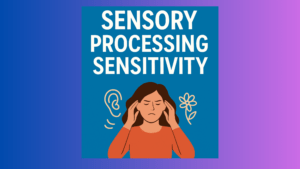-
Table of Contents
- What is it called when certain textures bother you?
- Understanding Sensory Processing Sensitivity
- Causes of Sensory Processing Sensitivity
- Symptoms of Sensory Processing Sensitivity
- Treatments for Sensory Processing Sensitivity
- Case Studies and Statistics
- Case Study 1: Emily
- Case Study 2: John
- Summary
What is it called when certain textures bother you?
Have you ever experienced a strong aversion or discomfort towards certain textures? Perhaps the feeling of touching velvet or the sound of nails on a chalkboard makes you cringe. If so, you may be experiencing a condition known as sensory processing sensitivity or sensory processing disorder. In this article, we will explore what this condition is, its causes, symptoms, and potential treatments.
Understanding Sensory Processing Sensitivity
Sensory processing sensitivity (SPS), also known as sensory processing disorder (SPD) or sensory over-responsivity, is a condition in which individuals have heightened sensitivity to sensory stimuli. This means that they may experience an intense reaction to certain textures, sounds, smells, tastes, or visual stimuli that others may find tolerable or even enjoyable.
SPS is not a recognized disorder in the Diagnostic and Statistical Manual of Mental Disorders (DSM-5), but it is widely acknowledged by researchers and clinicians as a valid condition that can significantly impact an individual’s daily life.
Causes of Sensory Processing Sensitivity
The exact causes of sensory processing sensitivity are still not fully understood. However, research suggests that both genetic and environmental factors play a role in its development.
- Genetic Factors: Studies have shown that there is a genetic component to sensory processing sensitivity. Some individuals may be born with a predisposition to heightened sensory sensitivity.
- Environmental Factors: Certain environmental factors, such as early childhood experiences or trauma, may also contribute to the development of sensory processing sensitivity. For example, a person who has experienced a traumatic event involving a specific texture may develop an aversion to it.
Also Read
Sensory Processing Sensitivity Symptoms: 10 Signs You’re Highly Sensitive (HSP)
Symptoms of Sensory Processing Sensitivity
Individuals with sensory processing sensitivity may exhibit a wide range of symptoms. These symptoms can vary in intensity and may manifest differently in different individuals. Some common symptoms include:
- Hypersensitivity to textures: Individuals with sensory processing sensitivity may find certain textures uncomfortable or even painful to touch. For example, they may dislike the feeling of sand, certain fabrics, or even the texture of certain foods.
- Overwhelm in sensory-rich environments: Sensory-rich environments, such as crowded places or loud events, can be overwhelming for individuals with sensory processing sensitivity. They may feel anxious, irritable, or even experience physical symptoms like headaches or nausea.
- Heightened emotional responses: People with sensory processing sensitivity may have stronger emotional reactions to sensory stimuli. For example, a certain smell may trigger a strong emotional response or a particular sound may make them feel extremely anxious.
- Difficulty filtering sensory information: Individuals with sensory processing sensitivity may have difficulty filtering out irrelevant sensory information. This can make it challenging for them to focus or concentrate in noisy or visually stimulating environments.
Treatments for Sensory Processing Sensitivity
While there is no cure for sensory processing sensitivity, there are various strategies and treatments that can help individuals manage their symptoms and improve their quality of life. Some common treatments include:
- Sensory integration therapy: This therapy aims to help individuals with sensory processing sensitivity gradually become more comfortable with sensory stimuli that bother them. It involves exposing them to controlled and graded sensory experiences to desensitize their responses.
- Cognitive-behavioral therapy (CBT): CBT can help individuals with sensory processing sensitivity identify and challenge negative thoughts and beliefs related to their sensory experiences. It can also teach them coping mechanisms and relaxation techniques to manage their symptoms.
- Environmental modifications: Making modifications to the individual’s environment can also be helpful. For example, using noise-canceling headphones in noisy environments or providing alternative textures for certain activities.
Case Studies and Statistics
Let’s take a look at a couple of case studies and statistics to better understand the impact of sensory processing sensitivity:
Case Study 1: Emily
Emily is a 10-year-old girl who has always been sensitive to certain textures. She finds the feeling of sand on her skin unbearable and refuses to wear clothes made of certain fabrics. This sensitivity has caused her distress and limited her participation in activities like going to the beach or shopping for clothes. After undergoing sensory integration therapy for several months, Emily’s sensitivity to textures has significantly reduced, and she can now engage in activities she previously avoided.
Case Study 2: John
John is a 35-year-old man who experiences overwhelming anxiety in crowded places. The noise, visual stimuli, and physical sensations make him feel on edge and unable to enjoy social events. Through cognitive-behavioral therapy, John has learned relaxation techniques and coping strategies to manage his anxiety. He now feels more confident attending social gatherings and has a better quality of life.
According to a study published in the Journal of Abnormal Psychology, approximately 15-20% of the population may have sensory processing sensitivity to some degree. This suggests that a significant number of individuals may experience challenges related to sensory stimuli.
Summary
Sensory processing sensitivity, also known as sensory processing disorder or sensory over-responsivity, is a condition characterized by heightened sensitivity to sensory stimuli. It can cause individuals to experience discomfort or aversion towards certain textures, sounds, smells, tastes, or visual stimuli. While the exact causes of sensory processing sensitivity are not fully understood, both genetic and environmental factors are believed to play a role. Treatment options include sensory integration therapy, cognitive-behavioral therapy, and environmental modifications. Case studies and statistics highlight the impact of this condition on individuals’ lives and the importance of effective management strategies.
By understanding and acknowledging sensory processing sensitivity, we can create a more inclusive and supportive environment for individuals who experience heightened sensory sensitivity.
✅ FAQ
Why do certain textures make me uncomfortable?
Certain textures may cause discomfort due to sensory processing sensitivity. This is often linked to Sensory Processing Disorder (SPD), autism spectrum disorder (ASD), or ADHD, where the brain processes sensory input differently.
Is texture sensitivity an ADHD thing?
Yes, texture sensitivity can be associated with ADHD. Many people with ADHD experience sensory challenges, including being bothered by fabrics, food textures, or surfaces.
What’s it called when textures bother you?
When textures cause discomfort, it’s called tactile defensiveness or sensory processing sensitivity, often connected with SPD, ADHD, or autism.
Do I have SPD or autism?
Only a qualified healthcare professional can diagnose SPD or autism. Both conditions can involve texture sensitivity, so if this affects daily life, consulting an occupational therapist or psychologist is recommended.
Are people with ADHD tactile?
Yes. People with ADHD may seek tactile input (fidgeting, touching, stimming) but can also be overly sensitive to certain textures.
Do people with ADHD have higher IQ?
ADHD does not determine intelligence. People with ADHD can have average, below-average, or above-average IQs. ADHD mainly affects attention and executive functioning.
What is stimming ADHD?
Stimming in ADHD refers to repetitive behaviors such as tapping, fidgeting, or playing with objects. It helps regulate emotions, relieve stress, and manage sensory input.
Why am I suddenly so sensitive to textures?
Sudden sensitivity to textures can happen due to stress, neurological changes, or sensory overload. If it’s persistent, it’s best to consult a healthcare provider.
What does overstimulation look like?
Overstimulation may cause irritability, anxiety, restlessness, difficulty focusing, headaches, or a strong urge to escape overwhelming environments.
How to fix texture sensitivity?
Texture sensitivity can be managed through occupational therapy, sensory integration techniques, gradual desensitization, sensory-friendly clothing, or tools like weighted blankets.
Also Read- 👉
👉 NASA-Approved 30-Min Brain Boost
👉 What Is The Healing Power Of Sound Wave
👉 What does 528 hz do to the brain?
👉 The 7 Healing Frequencies: Unlocking the Power of Sound for Wellness
👉 The Sacred Science of Yantras: How Cymatics Validates Ancient Tantric Geometry
👉 Is 1111 a Lucky Number? A Deep Dive into Its Mystical, Numerological, and Cultural Significance
👉 Is 528 Hz Dangerous?
People Also Read
- 2030 A Doomsday According to Indian Texts or Misinterpretation?
- The Glory of Narasimha Bhagwan: An Exploration of Ancient Indian History
- Medusa and Mansa Devi: The Untold Myths Connecting Greek and Hindu Traditions
- “The Enigmatic Link Between the Bermuda Triangle and Hindu Mythology of Ramayan: Unveiling the Mystery”
- why is mt. Kailash Considered to be a Sacred Site?
- How Eastern Wisdom Can Transform Your Modern Life.
- Lord Shani and Lord Yam : God of Karma for Living and Death
- In which direction Ganesh Idol should face.
- What is the logic for existence of God?
- Who Is Mahadev Shiv ?
- How to increase love for Krishna?
- Hanuman Chalisa English Lyrics| Bhajle Ram Naam | Prashyant Jha
Free AI Tools To test yourself
- Love Percentage Checker Tool – Check For Free!
- Soulmates Initial Finder
- Hz Frequency Generator- Free Online Tone Generator
- Mental Health Check In Tool [ FREE TEST ]
- Best Free Phone Photos Download
- Image Converter (Online & Free)
Seotoolrank.com Free Ai Tools
- RankVortex – Implies pulling traffic and SEO rankings toward you.
- How do I convert a PNG file to BMP?
- ConvertEase PDF
- Website Speed Checker Tool
- SEO Word Counter with Character Count
- Free Stopwatch and Online Timer Countdown
- Age Calculator Tool
- Password Generator Tool
- Qr Code Generator Free
- AI Story Generator Tool
- Blog Title Generator Tool [FREE]





